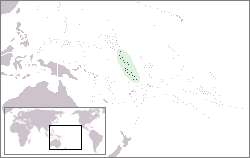Gilbert and Ellice Islands: Difference between revisions
Vinhtantran (talk | contribs) m +vi |
No edit summary |
||
| Line 25: | Line 25: | ||
==Bibliography== |
==Bibliography== |
||
Barrie Macdonald, ''Cinderellas of the Empire'': towards a history of Kiribati and Tuvalu, Suva, Fiji : Institute of Pacific Studies, [[University of the South Pacific]], [[2001]], ISBN 982-02-0335-X ([[Australian National University]] Press, first published it in 1982). |
Barrie Macdonald, ''Cinderellas of the Empire'': towards a history of Kiribati and Tuvalu, Suva, Fiji : Institute of Pacific Studies, [[University of the South Pacific]], [[2001]], ISBN 982-02-0335-X ([[Australian National University]] Press, first published it in 1982). |
||
Sir Arthur Grimble: "A Pattern of Islands". A sympathetic and often amusing account by a British official sent to the islands in his early 20's who stayed to become Commissioner. |
|||
Not in print but available second hand. US title: "We Chose the Islands" |
|||
{{Territories of the British Empire}} |
{{Territories of the British Empire}} |
||
Revision as of 14:47, 29 October 2007

The Gilbert and Ellice Islands were a British protectorate from 1892 and colony from 1916 until 1 January 1976 when the islands were divided into two different colonies which became independent nations shortly after. The Gilbert Islands have been the major part of the nation of Kiribati since 1979, and the Ellice Islands became Tuvalu in 1978.
The protectorate was generally established on this area (but not on these islands) by the Pacific Islands Protection Act of 1857, and then in 1877 for the Western Pacific Territories, but the protectorate on the Gilbert group and on the Ellice group was formal and effective only from 1892, and a High Commissioner was appointed in 1893. The islands became a Crown Colony on 12 January 1916. The colony's capital was mainly on Banaba Island (Ocean Island) and after World War II on Tarawa, first in Betio islet then near Bairiki.
The sixteen islands of the Gilberts, declared a protectorate by Captain Davis, R. N. of HMS Royalist between 27 May and 17 June 1892, were discovered intermittently from perhaps as early as 1537 up to 1826. The Ellice Islands were declared a protectorate by Captain Gibson, R. N. of HMS Curacao between 9th and 16 October of the same year; Banaba (or Ocean Island) was included within the protectorate in 1900 and then in the colony in 1916. In the same year, Fanning Island and Washington Island were included in it together with the islands of the Tokelau or Union Islands; Christmas Island was included in 1919 but was contested by the USA. The Tokelaus were detached in 1925 (but not formally until just after WWII); the Phoenix Islands were added in 1937 and the five islands of the Central and Southern Line Islands were added in 1972.
In 1974, ethnic differences within the colony caused the Polynesians of the Ellice Islands to vote for separation from the Micronesians of the Gilbert Islands (later Kiribati). The following year, the Ellice Islands became the separate British colony of Tuvalu.
Naming
The islands were named the Gilbert Islands in 1820 by a Russian admiral, Adam von Krusenstern, and French captain Louis Duperrey, after a British captain, Thomas Gilbert, who crossed the archipelago in 1788.
The Ellice Islands were named after Edward Ellice, a British politician and merchant, by Captain Arent de Peyster, who sighted the islands in 1819 sailing on the ship Rebecca. Ellice owned the cargo of the ship.
Postage stamps


Originally mail service was ad hoc, depending on which ships were calling at the various islands. A regular service began in 1911; Edward VII postage stamps of Fiji were overprinted GILBERT & ELLICE / PROTECTORATE and put on sale on 1 January of that year, followed in March by a set of four stamps depicting a Pandanus tree, inscribed GILBERT & ELLICE ISLANDS / PROTECTORATE.
These were followed in 1912 by George V stamps of the common type, inscribed GILBERT & ELLICE ISLANDS. A new definitive series came out starting 14 January, 1939, featuring local scenery and a profile of George VI. These were updated in 1956 with a profile of Elizabeth II.
A set of four stamps on 1 May 1960 commemorated the 60th anniversary of the discovery of phosphate at Ocean Island. The definitive series of 1965 depicted daily activities of the natives, but a decimal currency conversion necessitated surcharges in 1966 and a reissue of the stamps in 1968. The colony issued about 10-15 stamps per year thereafter, usually as sets of four, until the end of 1975.
Bibliography
Barrie Macdonald, Cinderellas of the Empire: towards a history of Kiribati and Tuvalu, Suva, Fiji : Institute of Pacific Studies, University of the South Pacific, 2001, ISBN 982-02-0335-X (Australian National University Press, first published it in 1982). Sir Arthur Grimble: "A Pattern of Islands". A sympathetic and often amusing account by a British official sent to the islands in his early 20's who stayed to become Commissioner. Not in print but available second hand. US title: "We Chose the Islands"
